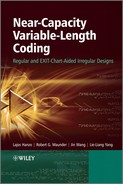Subject Index
Additive white Gaussian noise (AWGN)
Additive white Gaussian noise channel
Aging
AR model properties
area property
asymmetric RVLC
Autoregressive model
average codeword length
Average conveyed mutual information per symbol
Average error entropy
Average information loss
Average joint information
Average loss of information per symbol
backward recursion
Bahl–Cocke–Jelinek–Raviv (BCJR) algorithm
Bayes’s rule
Binary Phase Shift Keying (BPSK)
Binary symmetric channel example
canonical Huffman code
Canterbury Corpus
Capacity of continuous channels
Capacity of discrete channels
Channel
channel capacity
Eb/N0 bound
loss
channel coding
Channel coding theorem
Channel encoder
Channel impairments
channel-optimized source coding
Coaxial cable
code constraint
Code efficiency
Coding efficiency
coding rate
combined module
Communications channels
Communications system design considerations
computational complexity
convergence distance
Cumulative density function
curve-fitting problem
cutoff rate
divergence distance
effective throughput
entropy
Entropy of analog sources
Entropy of sources exhibiting memory
Equivocation
Error entropy
Error entropy via imperfect channels
error propagation
error shoulder
EXIT tunnel
extended code
EXtrinsic Information Transfer (EXIT)
chart
decoding trajectory
matching
tunnel
function
first-order Markov model
fix-free
forward recursion
Four-state Markov model for a two-bit quantizer
frame differencing
free distance
lower bound
metric
Free-space
Gaussian
Gaussian noise
Generating model sources
Genetic Algorithm (GA)
Group delay
Hamming distance
Hamming weight
hard information
histogram
Huffman code
Huffman coding
codebook
Ideal communications system
Information loss
Information loss via imperfect channels
Information of a source
Information properties
Information sources
Information theory
instantaneously decodable
inter-frame redundancy
interleaver
intra-frame redundancy
Irregular Convolutional Coding (IrCC)
irregular trellis
path
state
transition
Irregular Unity Rate Coding (IrURC)
Irregular Variable Length Codes (IrVLCs)
Irregular Variable Length Coding (IrVLC)
Issues in information theory
iterative decoding
convergence
Jacobian logarithm
Joint information
joint source and channel coding
Kraft inequality
latency
Levenshtein distance
Linde–Buzo–Gray (LBG) algorithm
Log-MAP algorithm
Logarithmic Likelihood Ratio (LLR)
loss of synchronization
lossless compression
lossy compression
macro-block
MAP/ML Sequence Estimation
Markov model
Markov processes
Max-Log approximation
maximum achievable information rate
Maximum entropy of a binary source
Maximum entropy of a q-ary source
McMillan inequality
memoryless source
Microwave channels
minimum block distance
minimum convergence distance
minimum divergence distance
Minimum Mean Square Error (MMSE) Decoding
Modulator
mutual information
Mutual information example
N-state Markov model for discrete sources exhibiting memory
Noise
Noise – natural
Noise – synthetic
non-singular
Optical fiber
Peak Signal-to-Noise Ratio (PSNR)
Power spectral density
Practical evaluation of the Shannon–Hartley law
Practical Gaussian channels
prefix codes
Probability density function
Quadrature Amplitude Modulation (QAM)
quantization
Rayleigh fading channel
redundancy
residual redundancy
Reversible Variable Length Coding (RVLC)
codebook
decoding
encoding
RLC efficiency
Run-length coding
Run-length coding principle
RVLCs for the English alphabet
Sampling
separation theorem
sequence estimation
serial concatenation
Shannon’s channel coding theorem
Shannon’s message for wireless channels
Shannon–Fano coding
Shannon–Hartley law
side information
Signal-to-noise ratio
Skin effect
soft information
a posteriori
a priori
a posteriori
a priori
extrinsic
mutual information
Soft-In Soft-Out (SISO) decoding
source and channel coding separation theorem
Source coding
Source encoder
Speech systems
subcode
Symbol-by-Symbol MAP Decoding
symmetric RVLC
T-BCJR algorithm
Thermal noise
Time Division Multiple Access (TDMA)
Transducer
Transfer function
Transmission via discrete channels
Trellis Coded Modulation (TCM)
trellis encoder
turbo principle
turbo-cliff
Twisted pairs
Two-state Markov model example
Two-state Markov model for discrete sources exhibiting memory
Unequal Error Protection (UEP)
uniquely decodable
Unity-Rate Coding (URC)
unity-rate intermediate code
Variable Dimension Vector Quantization (VDVQ)
codebook
decoding
encoding
Variable Length Coding (VLC)
average codeword length
Variable-Length Codes (VLCs)
Variable-Length Error-Correction (VLEC) coding
bit-based trellis
codebook
symbol-based trellis
Vector Quantization (VQ)
video
block
coding
compression
information
Viterbi algorithm
Viterbi’s three lessons
VLECs for the English Alphabet
Waveguides
